Charging a Tesla FAQ
Last updated 22-Jul-2024
One of the most frequently asked questions after "how far can it go?" is "how do you charge it?", with the variation "how long does it take to charge?". And there isn't a simple answer. In this section, we cover everything you need to know about the types of chargers, the networks, how to find out what cables you need and a few other hints and tips when charging.
If you do not have a Tesla, then our Non Tesla supercharging guide provides information on how to use the Tesla supercharging network.
An electric car is just like any other car, the distance you can go on a given amount of fuel/energy varies by how you drive and even the weather. The rated economy or efficiency of an EV car is also laid down by a formal testing policy just like the figures you see for petrol and diesel cars. Unlike a petrol car, for an EV they quote the range the car has on a full charge rather than how many miles it can do on a gallon or how many litres of fuel are required for 100 km. There have been 3 different standards used, EPA, NEDC, and its replacement, the WLTP, each giving different results. Tesla by law, has to report the WLTP figures in some regions but otherwise prefer the EPA figures. Read our article on Tesla Range for a longer explanation of range itself, how measured and what happens in the real world, and what a Tesla displays.
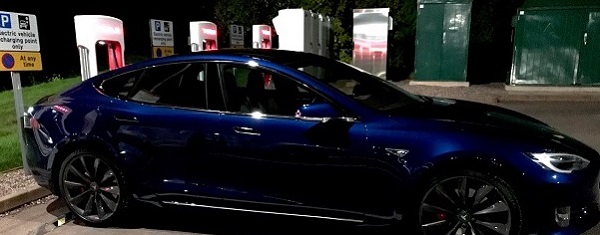
Terminology
Before diving into the detail of charging options it's worth explaining the basics on what all the different terms mean:
-
Kilowatt or kw
A watt is 1 amp x 1 volt, however, this isn't that practical so we use kw which represents 1000w, and is the rate of energy flow. This is a term where you don't really have an equivalent on petrol cars. When charging, it's the rate at which energy is being put into the battery. The nearest thing with a petrol car would be how fast you can fill your petrol tank up, something that isn't quoted as it's largely irrelevant.
Where it gets a little confusing is on an electric car, the energy flow when being driven is also measured in kw and is therefore roughly the power of the car. On a petrol car we would measure this using bhp.
-
Kilowatt hour or kwh
This is the amount of electricity and is equivalent to the amount of fuel (ie gallons or litres) you might put into a petrol car. You might say an EV car has an 85kwh battery in the same way you might say a car has a 10 gallon petrol tank. There is a slight variation of this as some cars use the Amp Hour or Ah unit of measure, this assumes the voltage of the battery is largely stable which it is. If you multiply the kw figure by time you get kwh - i.e. if the rate of flow is 7kw and you charge for two hours you have delivered 7 * 2 = 14kwh. Equally, 120kw for 15 minutes (0.25 of an hour) will deliver 120 * 0.25 = 30kw.
-
AC v DC charging
When you charge your car you can use either AC or DC. Alternating current or AC is the type we get at home and at the slower public charge points (sometimes confusingly called fast chargers). The rate of charge (in kw) is the product of the voltage and current. The US have various Voltage options, whereas Europe operates at 220-240 Volts. Using a 230V supply and 16 Amps you'd get 230 x 16 = 3680 Watts or 3.7kw. At 32 Amps you would have 230 x 32 = 7.4kw. When charging, the voltage can fluctuate and as a result these numbers can go up or down a little.
In UK and Europe, there is also the option of 3 phase AC power supplies. In essence, this is like having 3 separate 230V power supplies, all slightly out of step(phase) with each other. The result of this is that when drawing 16 Amps on a 3P supply, you have 3 x 230 x 16 = 11kw. Some older Tesla's can take 32 Amps giving 3 x 230 x 32 = 22kw but later cars with the high-power charger are limited to 24A giving 3 x 230 x 24 = 16.5kw. Remember, this is the rate at which you can fill the battery.
In the US there isn't 3 phase but you can charge on AC at different voltage levels, either 110V or 220V and current of up to 48 Amps.
The batteries themselves are Direct Current or DC, so the maximum ratre the car can charge may be restriucted by the cars ability to convert AC to DC.
The cars can also charge using a DC supply directly which is what you get at superchargers and rapid chargers. As the batteries are DC, the car does not need to convert the power from AC to DC and can therefore operate at higher levels, this time limited by the maximum rate the cahrger can deliver and the maximum the battery can take, whichever is lower.
When charging the car and the charger negotiate the fastest current they can mutually handle taking into account the charger supply, the cable being used, the onboard AC to DC converter limit for AC charging, and the battery capacility. This is constantly adjusted as the car charges although is most noticeable on DC charging where the rate will slow down as the battery fills up, but in all events, the charge rate is limited by the lowest of all the elements in the chain.
-
Pulling it all together
Your car will have a battery which will have a capacity, something like 85kwh, in petrol terms that would be a tank of say 10 gallons.
When charging, the rate will vary depending on what you are using to charge, but typically this may be 7kw at home. If your battery was empty, at 7kw it would take 85 kwh / 7kw = 12 hours to fully charge - i.e. you would need to be adding 7kw for 12 hours to add 84kwh. If you were on a faster charger like a DC charger, because the rate is much higher, the time is correspondingly less. On a Supercharger delivering 100kw, the time would be 85 kwh/100kw = about 50 mins to go from empty to full.
But..
- the rate can vary over time as the car and charger work together to protect the battery and the electronics and as a result, the actual rates will be lower than the maximum theoretical values.
- Charging has some wasted energy so a little is lost in the process resulting in longer times
- You alomost never charge from 0 to 100%. Most people charging at home may chrge from say 30% to 80% adding only 50% of the battery capacity, something that can be done in 4-5 hours.
-
Why is my car charging slower than the AC rating of the charge point?
Tesla have used different AC chargers in the cars over the years. The maximums are
- 16A 3 Phase (ie 11kw), on all cars without an uprated charger and the Model 3 and Model Y
- 24A 3 phase (ie 17kw), on cars with the high-power charger option available on facelift MS and MX
- 32A 3 phase (ie 22kw, on pre-facelift MS with the twin charger option in countries where 3 phase is available
When charging on AC, once the car limit has been met, it cannot charge any quicker, irrespective of the capabilities of the charge point.
The charge rate is also the slowest combination of the cars capabilities, the charge point capabilities and the cable capabilities, with respect to both the number of phases and the maximum current, e.g. a 3 phase 16a cable on a single phase 32a charge point will result in 16a on single phase.
-
Why is my car charging slower than I imagined it would be on DC charge point?
All charging is the slowest of the supply, the connecting cables, the actual charge that converts AC to DC and the battery. When supercharging the limiting factor is typically the battery. Once the battery starts to fill up the maximum rate will fall, if the battery is either too hot or more typically too cold the limit will be lower, all these things slow the charge rate down and above 80% the maximum charge rate starts to become notably slower.
The supercharger itself can also play a role. The V3 and V4 chargers are limited to 250kw whereas the older V2 superchargers are limited to 150kw and they also work in pairs so if 2 cars are charging the supply has to be shared which further reduces the maximum speed.
-
So why quote miles per hour charging speed?
While quoting kw and kwh is technically correct, it's not very intuitive to many. To try and help, although arguably it adds to the confusion, we sometimes quote how many miles are being added or are currently stored. This is calculated using the EPA rated consumption figure which gives a number of miles for each kwh and varies slightly by model. If a car can do 3.3 miles for each kwh, and in 1 hour on a 7kw charger we can add 7kwh, we can say the car is adding approx. 3.3 x 7 or 23 miles of range per hour charging or 23 mph (not to be confused with speed!).
If you're still unsure about the miles display, see Tesla Range explained
-
Chademo and CCS
In many countries, the rapid chargers were either CCS or Chademo hoever outside the US most countries are now adopting CCS as the standard, and whilst in the US there are still a number of different standards, the North American Charging Standard (NACS) is now being widely adopted.
-
Level 1 2 and 3 charging etc
Not to be confused with Type 2 charging, these are a set of charging definitions which determine the type of charging setup, ie either home charging, at a fixed AC charge point, at a rapid charger etc.
Ways of charging
When you charge you are adding energy to the batteries and the rate at which that happens depends on the way you charge. We've included a MPH figure (multiply by about 1.5 for km/h) for each type of method as drivers tend to find it easier to think this way, however, this is only indicative and can vary between cars and driving conditions. The lower end of the figures are for the Model X and the higher end of the range is for the Model 3 as an Model 3 can travel much further on a single kwh than a MX. Most users will want to charge in one of the following ways:
-
Universal Mobile connector(UMC)
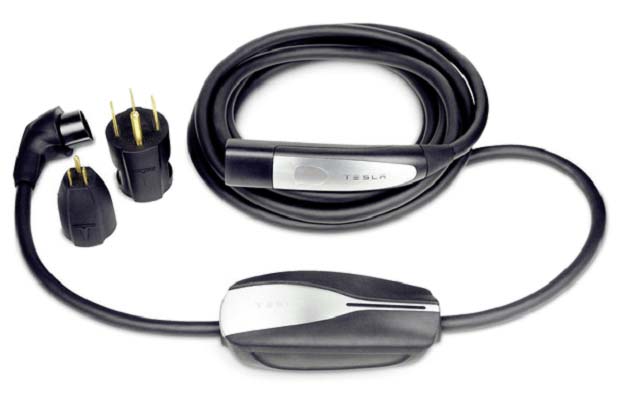 Typically 5-30 mph
Typically 5-30 mphThe Universal Mobile connector (UMC) is the portable charger, sometimes called a granny charger, that allows you to charge from a number of different electricity sockets via the choice of adapter. These used to be provided as standard with each car but is now an optional extra.
The most basic type is for a regular domestic socket and is the slowest option, in the US the supplied adapter is a NEMA-14-50, in the UK a three-pin plug and in Europe a Schuko. Other connectors are available for different socket types and the charger is intelligent to know which connector is being used and match the max current draw and voltage to maximise the available charge speed. In the US this is up to 14-50 and 6-50 connectors. In Europe the maximum is 32A commando or for the earlier UMC1 3 phase 16A.
To use, simply match the connector to the socket and plug in. Try to avoid extension leads or if you do use one capable for the task and uncoil fully to prevent heat build-up. It is also important not to use plug adaptors that result in a higher performance adapter on the UMC than the supply, for instance converting a 16A Schucko to a UK 13A supply through a mains adapter as this will overload the supply.
Until 2019 in Europe, Tesla supplied a UMC1 which came with a 32A commando plug but could also take a Red 16A 3 phase plug. From mid 2019 and on all M3, Tesla supplied the UMC2 which supports either a smaller 16A socket, useful as this is the size often found in marinas, caravan parks, and some ferries or you can get a 32A adapter for this as 16A and 32A are different sizes. The UMC2 does not support 3 phase charging at all. If you opt to use the 3 pin plug, even though this is by far the slowest way of charging, be careful not to overload the circuit, and if you are using an extension cable make sure it is fully unwound.
From 2022, in some countries Tesla have stopped providing the UMC and this is expected to become the case across all markets over the year. You can still buy a UMC from a Tesla Service Centre or but a 3rd party one.
-
Home Charger
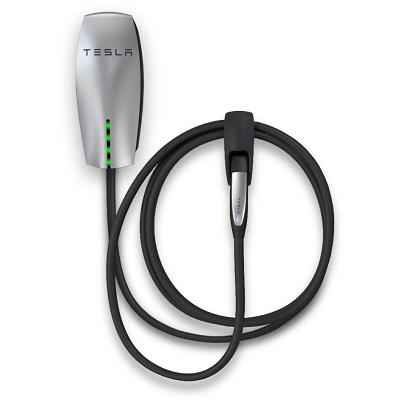 Typically 20 - 30 mph when on single phase
Typically 20 - 30 mph when on single phaseThis is effectively a box on the wall that has the electronics built-in, rather than the UMC mentioned above. They can come with either a tethered cable or a socket. All you need to do is use the tethered cable, or if the version is one with a socket, a Type 2 cable to the car. You can get 3 phase versions including 32A ones which will be pretty quick, but they cost more and require 3 phase supply to your home. They are about 50% quicker unless you have dual chargers or the high-power charger option in your car. The preference over Commando and a charge point, and whether to go tethered v untethered are all personal choice and often influenced by the grants available although we would not recommend daily use of the UMC2. Tesla make the nicest version but it's also the most expensive.
-
Supercharger
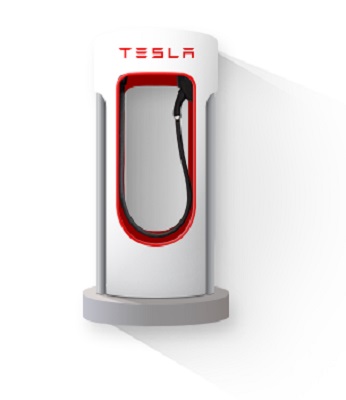 60-1000+ mph
60-1000+ mphTesla Superchargers just need plugging in and depending on a whole host of factors can put in anything up to 1000 miles per hour. The higher the state of charge in the car, the slower the charging so they work fastest when arriving nearly empty and charging to about 70%. Selecting the supercharger in the Satnav before getting there will also cause the car to precondition for the optimum charge rate.
Earlier V2 Chargers are in pairs and both can't deliver the maximum charge rate at the same time. So, if you have a choice, always be the only car on a charger pair (they have 1A and 1B written on them).
There are also V3 and V4 superchargers. These offer even faster charging where the car allows but are CCS only in Europe and some other regions. The Model S and Model X from 2019 in these areas come with an adapter and cars made before then can be converted to take CCS although the speed is still limited on these cars.
As mentioned in Europe all superchargers have a CCS cable which is a commonly used standard. Increasingly Tesla are allowing other makes of car to use these chargers initiating a charge via the Tesla app. This has caused some frustration as depending on the location of the charge port, these non Teslas may end up blocking 2 chargers.
Superchargers also have penalty charges for leaving your car connected after charging has completed if the location is half full or greater, and in some areas Tesla are also charging if you continue to charge beyond a certain level where charging is very slow.
A note on charging etiquette. Other than V3 and V4 chargers, they are in installed in pairs and share a supply capacity, usually between 120 and 150kw. They are numbers 1A, 1B, 2A, 2B etc to show the pairings. It used to be the case the first car got pretty much all it could take with the second car getting the balance but this seems to have changed and the capacity is now split equally between the two cars, with one car only getting more if the other car cannot take its allocation because, say, it's nearly full or has a very cold battery. As a result, sharing a charger pair not only limits the speed at which you can charge but may also hamper the other car on the pair already charging. It's always best to try and be the only car on a charger pair, only sharing when there are no other options.
-
Rapid charger from CCS
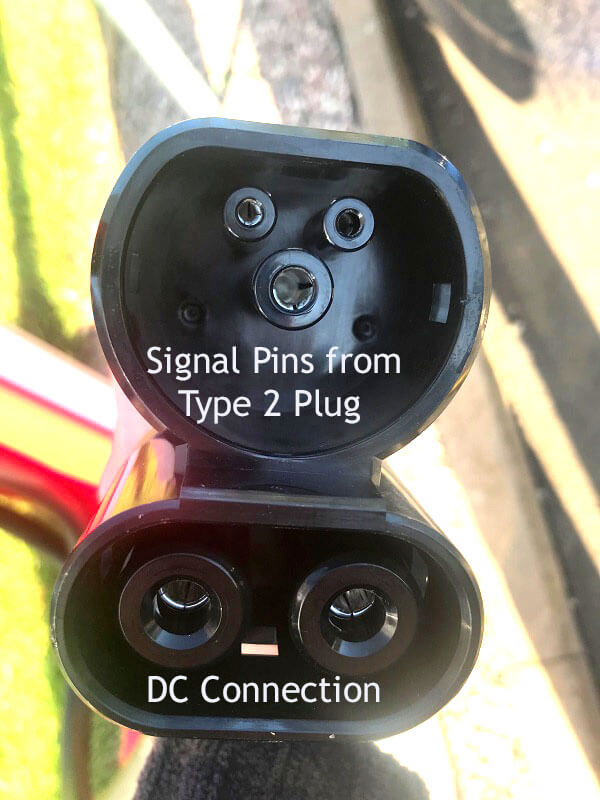 100-360+ mph
100-360+ mphThe European standard for Rapid Chargers is now CCS and this is becoming increasingly common in other countries. The CCS connection is essentially the Type 2 AC charging socket but with the addition of the DC connection to increase the size of the connection.
The Model 3 and Model Y in Europe come with a CCS port as standard. The MS and MX from 2019 come with an adapter to extend the Type 2 socket to a CCS socket through the addition of the bottom DC pins, and this can be retrofitted to earlier cars.
The CCS standard can charge up to 350kw although the actual speed of charging will be limited by the lower of the charge point and what your car can take. The standard also supports 800V, something Tesla currently do not support. As a result, even on a 350kw charger, the maximum charger rate on a Tesla will be 175kw or so, which is still pretty good but a little way behind the V3 superchargers 250kw.
Most Model S and Model X require an adapter to CCS charge. This is region dependant.
-
Destination or Fast charger
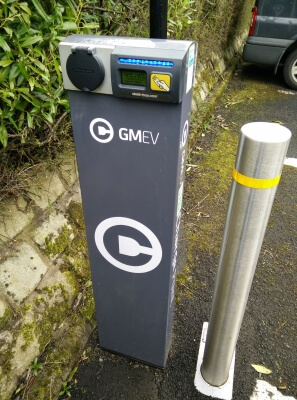 Typically 20 mph on single phase, to a max of 60 mph on 3 phase
Typically 20 mph on single phase, to a max of 60 mph on 3 phaseThese are slower and similar to the charger you may have at home. They all typically charge at 20-25 miles per hour depending on the model, although some are only half that rate if 16A. They can be found in some car parks, railway stations, restaurants, hotels etc. The idea is you will be leaving your car there for a while so a slower rate of charge is fine. These are latched to the car so can't be stolen while you are away and are typically started with an app or membership card.
While these are sometimes referred to as fast chargers, this is a legacy term with reference to charging at home on the UMC.
We generally find that when using a card to start a charger, it is sometimes best to use the card to initiate the charger before plugging in.
Most destination chargers require you to use your own Type 2 cable.
-
Tesla destination chargers
 Typically 20 mph on single phase, to a max of 60 mph on 3 phase
Typically 20 mph on single phase, to a max of 60 mph on 3 phaseThese are like other destination chargers although they can often be 3 phase which gives a charging boost. They also sometimes load share where one charger will deliver as much as it can, but if two chargers are in use, the power supply may be split so that both cars can charge. They are also tethered so you don't need a cable. These tend to be found at hotels, restaurants, and other places where you might want to visit and if you are reliant on the charger, you should ring ahead to check access, many places require you to use their facilities although they may offer the charging for free in return. Look out for the signs behind the chargers, those with a red background are for Tesla cars only, the white background are suitable for any car that can take a Type 2 cable. It's not uncommon for people to be confused over whether non-Tesla's can charge at a Tesla charger, the only time it works is on a Tesla Destination Charger with a white background or a Tesla home charger.
Car charging networks
Many EV owners charge their car overnight at home and rarely need to charge on a public network. Others travel extensively and rely heavily on them. But all owners need to be aware of what networks exist, how much they cost, and what you need to be able to use them.
A word of warning when using any charger. Most chargers are effectively in a car park, and terms and conditions apply. Please don't assume parking is free, sometimes it is so long as you register at the reception, but not always.
-
Tesla Superchargers
Free for some cars especially early MS and MX.
No app required, payment is taken from the card registered on your MyTesla account.
Overstay charges apply if you remain connected after charging and the site is 50% or greater occupied.
These are the Tesla superchargers you find usually on main travel routes. They used to only work on Tesla cars even if other cars support the same plug type, but increasingly Tesla are opening these up to other makes of car, mainly in Europe. There is talk of a V4 Supercharger in the US with 2 cables which will enable other makes of car to use them in the US too.
There are more than one type of supercharger, the most common is the V2 standard with a limit of around 150kw and shared between two bays, so alternate chargers are best used if possibly. The fastest charger is the V3 charger supporting up to 250kw although not all cars can make use of this extra performance, and in Europe you will need to the CCS upgrade/adaptor on Model S and Model X cars.
-
Tesla Destination Chargers
Free although aimed at those owners who are using the facilities at the location.
Please check with the establishment over terms of use.
No app required.
These are aimed at places where you will be leaving your car while using the venue facilities. The chargers should be free, and typically you may find 2 or 3 of the chargers, some of which will be dedicated to only Tesla cars indicated by the red background to the sign, while others will work with any car which can take the plug and indicated with a sign with a white background.
-
3rd party chargers
from free to quite expensive
Some require no app or membership
Others may require membership, dedicated cards, phone apps or contactless credit card
3rd party chargers vary a lot from place to place. Many slow destination chargers are free or may require an app or membership card. Rapid chargers are increasingly paid for but are moving to contactless credit card.
The amount you pay can vary not just between networks, but the same charge point may cost a different amount depending on how you pay. Some networks offer memberships schemes in return for cheaper charging.
How much does it cost?
As we mention above it can vary from location to location. In general, if you have to pay for charging it is usually more expensive than charging at home and so we would advocate charging at home wherever possible.
There are also variations from network to network on how you are charged. Some schemes have a membership model where you get a discount. Some charge by the kwh consumed. Some by the time connected. And some also charge a connection fee. There is no easy answer to how much it costs outside the Tesla network, and you have to research the network, however there are an increasing number of websites that collate and help inform on the various networks and their locations to make life easier.
To calculate how much it costs to supercharge is fairly simple. Tesla charge a kwh rate and this is displayed on the map if you select the supercharger and look at the additional information. It is worth noting that this can vary by time of day. You get charged for the number of kwh added to the car multiplied by the price per kwh and the car will tell you the running total of how much the cost is in the bottom right of the charging screen.
Because you may charge more often than fill up a gas car, and you may not start from empty and charge until full, the question that makes more sense to us is how much does it cost per mile/km added. This is complicated by the fact that the miles reported by the car are not always obtainable and in winter you may need to use more 'Tesla miles' to cover the 'actual miles'. But to try and give a cost calculator we thing the following can be used as a rough guide.
- Take the typical number of miles driven by your car per kwh. If your car says its average consumption is 320 wh/mile then divide 1000 by 320 = 3.125 miles per kwh. You can substitute km figures to give the number of kms driver per kwh. It should be noted, other makes of EV tend to use different measures for how much energy a car uses for distance covered, the alternative usually being how many kwh to cover 100km. We are using the Tesla metric.
- Take the cost per kwh where you are charging. This can vary from very low at home to quite high on some public chargers. For this calculation we will assume 45c per kwh.
- We need to factor in charging losses as these can be quite substantial. Tesla charge you per kwh after losses where other charge networks and home charging charge you for the actual amount of electricity consumed. The loss can be as high as 25%.
- To calculate the cost per mile, divide the unit cost by the miles driven, and then increase it by 25%. In the example above, 45c / 3.125 * 1.25 = 18c per mile.
The other common question is 'I will be charging at a friend's house overnight, how much electricity will it use?'. There are a couple of ways of working this out.
- Calculate the cost per mile using your friends home kwh tariff and then multiply by how many miles added. This is likely to slightly underestimate the amount used.
- Multiply the charge rate of the charger by the number of hours charging x the hourly rate (e.g. 3.6kw x 14 hours x 14c = $7
Both the above methods are a little complex and requires additional information, but the key thing to remember is electric cars are generally cheap to charge, certainly in comparison to petrol, so be generous to your friends and err on the side of over payment, they may simply refuse to take payment anyway.
Charging Etiquette
It can be a quite contentious subject amongst owners on the correct etiquette when using public chargers. Tempers can become especially frayed when people are in need of a charge and they arrive to find a plugged-in car that appears to be charged. There is no way to tell if a Tesla is charging if it is locked, the lights on the charge port stop flashing shortly after a car is locked and some owners mistaken think the car is full.
We suggest the following as a general guide to charging etiquette
- On superchargers, only charge to as much as you need and if at all possible do not charge above 80% as the speed of charging will have slowed down considerably. On V2 style chargers, also try and avoid sharing a charger pair with another car if possible as this can halve the rate for both of you. Move the car as soon as charging has completed, overstay fees may be levied if you fail to do so.
- Public rapid chargers are similar to superchargers. These chargers may indicate on the charger if the car is still charging or has stopped which can annoy waiting owners, not to mention it is a general inconvenience to others. Move the car once charged.
- Destination chargers, you can remain plugged in while using the facilities, but if the car happens to be charged and it is convenient, then we suggest moving the car. As a general rule Tesla destination chargers are for the patrons of the destination rather than primarily for Tesla owners, so if you're not visiting the destination other than to charge, please check with the destination. As well as it being courteous, many destinations turn off the chargers and only turn them on for guests and as a result you may not be able to charge which could leave you in difficulty if you were relying on the charge.
- Public chargers are similar to destination chargers and we would generally refer to the purpose of the car park. A charger at a car park designed for shopping trips and typical stays of a few hours should be treated as such and the car not left on the charger for longer. A car park designed for all day parking then the car can be left all day. Car parks that may be for multiple days parking, e.g. at a railway station or airport can be used for the whole day although we would advise against leaving the car connected if the car will be left there for several days. It's possible the car will be fully charged at an airport car park before the plane has even taken off.
- Above all, treat others as you would like to be treated. There are times when exceptional events occur and we should be tolerant to those in that situation, but equally, if you live 5 miles from a railway station and you plug in and leave your car for 3 days because its free will potentially significantly be detrimental to others.